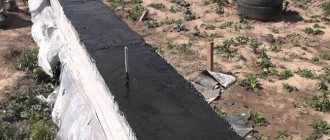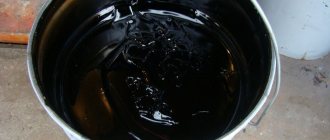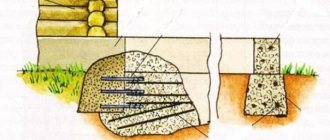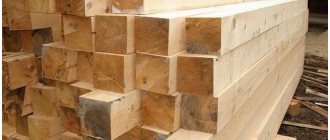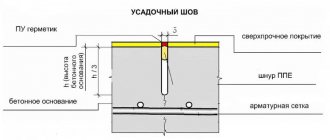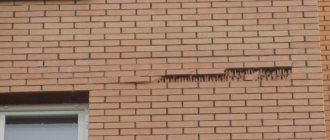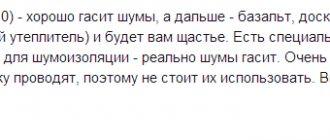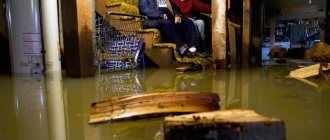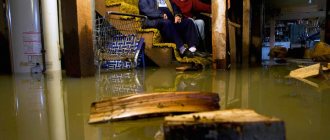General information about waterproofing seams
Waterproofing seams is designed to reduce heat loss, protect the room from drafts, noise, moisture penetration, and gradual destruction of building materials. Waterproofing seams and joints will help reduce heat loss by up to 30%. Installation of waterproofing joints is carried out outside and inside the premises. Waterproofing of joints is carried out during the construction of new and modernization of already constructed buildings. Modern materials for waterproofing are designed for 50 years of service, as they are made of foamed polyethylene and polyolefin.
Waterproofing dowels
This type of insulation consists of rubberized strips used for waterproofing and cold and expansion joints. At their core, waterstops are internal formwork, installed during concreting in places of greatest pressure on the concrete slab.
Advantages of waterstops:
The use of hydraulic gaskets in expansion and expansion joints allows the structure to withstand high loads and significant temperature fluctuations.
A wide selection of different types makes it possible to select a profile that meets both climatic and seismic conditions. And also keys can ensure the tightness of shrinkage joints with a large amplitude of vibration.
They are used mainly in the construction of new buildings, since installation in ready-made structures presents significant difficulties.
Disadvantages of waterstops:
With significant water flow pressure, the joining layer between the profile and concrete does not provide a 100% guarantee of impermeability.
Waterproofing materials
The following products are used for waterproofing:
- bitumen roll (roofing felt, roofing felt, stekloizol). They are cheap, but their service life is about 8 years, with the exception of glass insulation - lasts up to 20 years;
- mastic mixtures made on an adhesive basis. Service life 10 years;
- dry and liquid mixtures, last from a year to ten;
- made of foamed polyethylene and polyolefin, depending on the manufacturer, lasts from 25 to 50 years.
In order for polyethylene foam insulation to serve its intended life, a plastic composition of mastic or plaster is applied on top of it to protect it from ultraviolet radiation.
Criteria for choosing the type of waterproofing of seams
In order for the waterproofing of a construction joint to give the necessary and expected effect, when choosing materials and the method of execution, it is necessary to take into account such indicators as:
- Types of mobility of seams (movable, monumental, relatively mobile);
- Future load force. Estimated impact force that the joint must withstand;
- Activity of an aggressive environment;
- Temperature changes;
- Level of aggressiveness of ground or flood waters;
- Type of soil under the building;
- The location of the seam and the possibility of approaching it;
- The quality level of building materials used in the construction of the building;
- Type of work to be done (repair or insulation of a new seam);
- Objectives of the work: creating a waterproof layer, aesthetic water, increasing resistance and durability;
Depending on these indicators, the appropriate material is selected that best meets the tasks assigned to this type of seam. For concrete-based structures, the following materials and methods for waterproofing joints are offered:
- Swellable cords made of acrylate materials, bentonite clay or liquid rubber;
- Waterstops or profiles installed during the main concrete pouring process;
- Tapes fixed after complete completion of the structure using an adhesive composition or the pressing method;
- Method of injecting construction joints using materials such as: Polyurethane resins,
- Acrylic gel,
- Epoxy resins.
Quite often, several methods are used in combination to achieve maximum effect. Proper selection of materials and waterproofing methods allows you to achieve strength and reliability of butt joints.
Types of seams that need waterproofing
When building houses, it is important to pay special attention to the seams between the elements of building structures. Seam insulation is necessary to maintain a healthy microclimate and reduce noise levels in the room. Improperly sealed cracks lead to moisture penetration, the formation of fungus, mold, drafts, and gradual destruction of building materials. Most of the shortcomings are found during the installation of window, balcony blocks, and entrance doors. External interpanel seams also need insulation.
Waterproofing of concreting expansion joints
When performed correctly, expansion joints must be elastic, withstand significant temperature fluctuations, and not allow moisture and water to enter the room.
Reasons for water penetration into expansion joints using the example of a seam tape located inside (leaky sealing element)
Reasons for water penetration into expansion joints using the example of a seam tape located inside (water flow around the sealing element)
An expansion joint can meet all these requirements only after proper waterproofing. The calculation of the number of movable joints is carried out taking into account possible fluctuations in temperature conditions, and, accordingly, the expansion and contraction of concrete slabs, the expected size of shrinkage and possible deformations of the structure.
The most suitable for waterproofing expansion joints are:
- Profiles – dowels;
- Adhesive tapes;
- Elastic sealants made of polymeric materials (acrylic gels or acrylates).
In addition to the fact that waterproofing moving joints effectively protects seams from the harmful effects of water and mold, it does not allow the seams to become clogged, which significantly increases their service life.
Benefits of using acrylic gels
The ideal option for sealing shrinkage or expansion joints are acrylic gels. Acrylates are materials that do not allow moisture to pass under any conditions, are quite simple to use, and have significant elasticity to simultaneously maintain the strength and mobility of the deformation joint.
The advantages of these materials include the following qualities:
- High adhesion to all types of load-bearing structures;
- Resistance to a wide range of temperatures;
- Insensitivity to chemical environments;
- The ability to thicken and soften depending on the situation.
Filling seams with gel when a strain gauge element is damaged
Why waterproof an expansion joint?
When arranging waterproofing of various structures, in most cases it means protecting expansion joints, since they most often “suffer” from groundwater and sudden weather changes.
If previously waterproofing was a real problem, today this problem has been successfully solved. Expansion joints are important parts of structures and are necessary to compensate for various types of loads: sudden temperature changes during concrete shrinkage, forces exerted on the base during uneven shrinkage, etc.
One of the key conditions when constructing an expansion joint is the installation of waterproofing tape.
Many builders have had to observe how leaks form in expansion joints, which can cause a lot of problems when putting a building into operation and during its further maintenance. Such leaks can lead to rapid destruction of the foundation and subsequent expensive repairs.
The problem can be aggravated by periodic movements that occur in the seam itself. As practice has shown, waterproofing materials based on mineral-based binders have proven to be ineffective and cannot withstand a variety of loads.
Cost of work
As for the cost of waterproofing work, it depends on a large number of factors. These include the amount of work and the type of waterproofing materials used. It should be noted that there is:
- primary waterproofing - during the work process, a completely empty seam is filled with insulation, after which the cavity is filled with insulating compounds. Similar work is carried out during construction, when insulation is carried out for the first time.
- secondary - requires preliminary removal of old protective materials and cleaning of the seam cavity. Accordingly, the work turns out to be more labor-intensive and expensive compared to the first option.
To identify the most accurate list of required work, it is necessary for the on-site specialist to familiarize himself with the characteristics of expansion joints and the object as a whole. He will be able to determine, first of all, the best course of action in a particular situation, and the approximate cost of performing waterproofing work.
Waterproofing concrete joints
The most likely places for water leaks in structures made of waterproof concrete are expansion joints, junctions of vertical and horizontal structures, joints between prefabricated structural elements, and utility entries.
Expansion (temperature, sedimentation, anti-seismic and shrinkage) joints dividing the building into compartments are installed in the right places in the load-bearing and enclosing structures to prevent the appearance of random, unorganized cracks.
Technological (cold, working, structural) seams are made where the day's work on laying concrete has been completed.
Interruptions in concreting during the construction of structures, separate casting of the horizontal part and then the vertical part, or laying concrete on metal, stone, etc., for example, when concreting embedded parts and utility inputs, lead to the formation of so-called “cold joints.”
Cold joints in cast-in-place concrete structures are among the weak points in underground building structures and are the most common cause of water penetration.
Joints between prefabricated structural elements
Quite often, reinforced concrete blocks are used to build foundations or basements. In this case, the problem area is the joints between them.
The joints between structural elements are sealed using fine-grained cement-sand mortars. However, this creates cold (technological) seams, which in turn represent a potential place for water leakage.
To reduce the likelihood of leaks and increase the strength characteristics of butt joints, in recent times non-shrinking or slightly expanding dry cement-based building mixtures (see section “ Waterproofing mixtures” ) with high compressive strength (25-45 MPa) and water resistance ( W12-W16). However, it is advisable to additionally waterproof the butt joints formed using such mixtures with penetrating (penetrating) mineral compounds.
Pressure joints
Waterproofing of joints (when one reinforced concrete structural element is placed on another) is provided immediately before installation of concrete structures on concrete preparation.
To do this, it is recommended to apply a layer of mortar or dry powder of a penetrating cement-salt composition, a non-shrinking or expanding cement-based mortar onto the joint plane.
Strengthening waterproofing
In practice, it has been proven that strengthening flexible coating waterproofing along joints, abutments, mates and cold seams using reinforcing strips made of glass fiber materials (fiberglass, fiberglass) or geotextiles (density 100-150 g/m2) is an effective solution.
The use of reinforcing (strengthening) material ensures the distribution of tensile loads occurring in the waterproofing coating onto areas of the coating adjacent to the stressed zone and thereby preserves its integrity at the point of the load.
